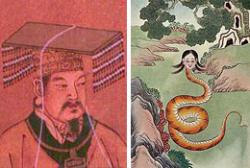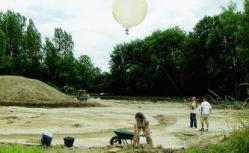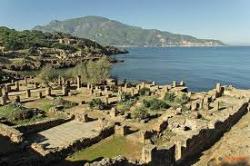INSTITUT SUPERIEUR D'ANTHROPOLOGIE
INSTITUTE OF ANTHROPOLOGY
ONLINE COURSES / COURS A DISTANCE
INSCRIPTION 2012 / Session III : Juillet 2012
REGISTRATION 2012 / Term III : July 2012
CHINE –  -Wang Wei, head of Institute of Archaeology under the Chinese Academy of SocialSciences, said to the reporter of People's Daily that judging from archaeologicalfindings, Chinese civilization indeed has a history of 5,000 years.The historical records of China take the period of Yellow Emperor and Yan Emperor asthe beginning of Chinese history and Chinese civilization is considered having a historyof 5,000 years.However, all the earlier records and narrations about the period of Yellow, Yan, Yao,Shun and Yu emperors are from the later historical records and many are legendarystories. Therefore, many people in academic circle are skeptical of the 5,000 years ofChinese civilization and some foreign scholars even doubt whether the Xia dynasty, thefirst dynasty in China, had really existed. "Only by archaeological excavation to get new evidences can these suspicions beeliminated. The latest archaeological research result is the hard evidence that Chinareally has a history of 5,000 years," Wang said. Archaeological excavation can provide important evidences. Wang said that with over 10 years’ exploration of the origin of Chinese civilization, it hasobtained an overall knowledge about the formation, evolution and stages of Chinesecivilization in early times. The Niuheliang Site in Liaoning province and Lingjiatan Site in Anhui province havehad about 5,000 years of history. The findings of large noble tombs, where buriedmany exquisite jade wares and vessels, and grand sacrifice sites indicate that the hierarchical differentiation had become serious in some places early in 5,000 years. The sites of some large cities and palaces such as Liangzhu Site and Taosi Siteexplained that before the establishment of Xia dynasty, the states had appeared insome regions which had a rapid development of culture and society and the civilizationof ancient states had begun since then, Wang said to the reporter. "The appearance of agriculture, handicraft, metropolises, serious social differentiation,pyramid-shaped structure and top leaders in these sites are earlier than that of the Xiadynasty and it shows that primary civilization and early states had already shaped atthat time, which is an important evidence to the 5,000 years ‘ history of Chinesecivilization," Wang said. The next step will focus on the research of early civilization in different regions. Wang pointed out that next they will deeply research early civilization in differentregions of China as well as the origin and formation of the overall Chinese civilization. It is said that the initial task of the third stage exploring the origin of Chinese civilizationhas basically finished and the later task is about to launch and will last until 2015.
-Wang Wei, head of Institute of Archaeology under the Chinese Academy of SocialSciences, said to the reporter of People's Daily that judging from archaeologicalfindings, Chinese civilization indeed has a history of 5,000 years.The historical records of China take the period of Yellow Emperor and Yan Emperor asthe beginning of Chinese history and Chinese civilization is considered having a historyof 5,000 years.However, all the earlier records and narrations about the period of Yellow, Yan, Yao,Shun and Yu emperors are from the later historical records and many are legendarystories. Therefore, many people in academic circle are skeptical of the 5,000 years ofChinese civilization and some foreign scholars even doubt whether the Xia dynasty, thefirst dynasty in China, had really existed. "Only by archaeological excavation to get new evidences can these suspicions beeliminated. The latest archaeological research result is the hard evidence that Chinareally has a history of 5,000 years," Wang said. Archaeological excavation can provide important evidences. Wang said that with over 10 years’ exploration of the origin of Chinese civilization, it hasobtained an overall knowledge about the formation, evolution and stages of Chinesecivilization in early times. The Niuheliang Site in Liaoning province and Lingjiatan Site in Anhui province havehad about 5,000 years of history. The findings of large noble tombs, where buriedmany exquisite jade wares and vessels, and grand sacrifice sites indicate that the hierarchical differentiation had become serious in some places early in 5,000 years. The sites of some large cities and palaces such as Liangzhu Site and Taosi Siteexplained that before the establishment of Xia dynasty, the states had appeared insome regions which had a rapid development of culture and society and the civilizationof ancient states had begun since then, Wang said to the reporter. "The appearance of agriculture, handicraft, metropolises, serious social differentiation,pyramid-shaped structure and top leaders in these sites are earlier than that of the Xiadynasty and it shows that primary civilization and early states had already shaped atthat time, which is an important evidence to the 5,000 years ‘ history of Chinesecivilization," Wang said. The next step will focus on the research of early civilization in different regions. Wang pointed out that next they will deeply research early civilization in differentregions of China as well as the origin and formation of the overall Chinese civilization. It is said that the initial task of the third stage exploring the origin of Chinese civilizationhas basically finished and the later task is about to launch and will last until 2015.
http://english.peopledaily.com.cn/102774/7880463.html
USA –  Lattimer - The grove of trees obscured signs of civilization, but Michael Roller searched anyway. Soon he and fellow archaeologist Paul Shackel noticed depressions where foundations had settled from houses that once stood at the end of a path off Canal Street in Lattimer. While sifting the dirt from each layer that they excavated, they found children’s marbles, glass shards, pottery chips, buttons and bits from pipes favored by tobacco smokers. As they dug deeper, they hit the rock foundations of homes built by coal miners as many as 120 years ago. The houses started collapsing in the 1940s and ‘50s. The archaeologists found indications that the homes had changed over the years. Homes drawn on successive maps took slightly different shapes. While digging, they found nails of different sorts and manufacture. Roller and Shackel theorized that miners often repaired or enlarged their homes, perhaps from scavenged materials. Coal companies like the Lattimer Coal Co., which began with the formation of the village in 1869, commonly sold blocks of land for miners to build on. In Lattimer, miners of Italian descent settled south of the main road. The miners who lived north of Canal Street where the excavators worked were Eastern European, Shackel said. A professor and chairman of anthropology at the University of Maryland, Shackel led a dig in 2010 at a site in Lattimer where sheriff’s deputies shot to death striking miners participating in a labor march on Sept. 10, 1897. Outcry over the massacre won sympathy for the United Mine Workers and other laborers who wanted to organize nationwide. Roller helped with the digging at the massacre site in 2010.
Lattimer - The grove of trees obscured signs of civilization, but Michael Roller searched anyway. Soon he and fellow archaeologist Paul Shackel noticed depressions where foundations had settled from houses that once stood at the end of a path off Canal Street in Lattimer. While sifting the dirt from each layer that they excavated, they found children’s marbles, glass shards, pottery chips, buttons and bits from pipes favored by tobacco smokers. As they dug deeper, they hit the rock foundations of homes built by coal miners as many as 120 years ago. The houses started collapsing in the 1940s and ‘50s. The archaeologists found indications that the homes had changed over the years. Homes drawn on successive maps took slightly different shapes. While digging, they found nails of different sorts and manufacture. Roller and Shackel theorized that miners often repaired or enlarged their homes, perhaps from scavenged materials. Coal companies like the Lattimer Coal Co., which began with the formation of the village in 1869, commonly sold blocks of land for miners to build on. In Lattimer, miners of Italian descent settled south of the main road. The miners who lived north of Canal Street where the excavators worked were Eastern European, Shackel said. A professor and chairman of anthropology at the University of Maryland, Shackel led a dig in 2010 at a site in Lattimer where sheriff’s deputies shot to death striking miners participating in a labor march on Sept. 10, 1897. Outcry over the massacre won sympathy for the United Mine Workers and other laborers who wanted to organize nationwide. Roller helped with the digging at the massacre site in 2010.
http://www.pennlive.com/midstate/index.ssf/2012/07/archeologists_hazleton.html
FRANCE –  Esclavolles-Lurey - Depuis le 14 juin, s'effectuent à Esclavolles-Lurey et très exactement sur la « Pièce de Bécheret », des fouilles archéologiques menées par l'Institut national de recherches archéologiques préventives. Pour pouvoir reconstituer plus précisément les différentes habitations anciennes et mieux comprendre les alignements des trous de poteaux mis à jour, pour obtenir des relevés différents de ceux notés sur le terrain et enfin, pour avoir une vision globale du terrain, Arnaud Remy, qui dirige les fouilles, a fait venir, lundi, sur le site la société « Vertical Photo » créée par Frédéric Canon, un spécialiste de la photo aérienne. Voilà sept ans que ce dernier, qui vient de Beine Nauroy dans la Marne, s'est spécialisé dans la photo aérienne en ballon captif (ballon relié au sol). Son ballon, qui transporte un appareil photo perfectionné, peut grimper jusqu'à 150 mètres, tandis qu'il manie les télécommandes depuis le sol. Ce type d'appareil, qui fut utilisé pendant la guerre pour surveiller les ennemis, permet de réaliser des photos aériennes sous des angles inédits et des photos panoramiques. Il ne fait aucun bruit et ne produit aucune pollution. « On voit très bien les habitations, les sépultures, l'enclos funéraire et l'ensemble du site », a confié le photographe qui a réalisé toute une série de photographies sur les importantes fouilles qui se termineront à la fin du mois.
Esclavolles-Lurey - Depuis le 14 juin, s'effectuent à Esclavolles-Lurey et très exactement sur la « Pièce de Bécheret », des fouilles archéologiques menées par l'Institut national de recherches archéologiques préventives. Pour pouvoir reconstituer plus précisément les différentes habitations anciennes et mieux comprendre les alignements des trous de poteaux mis à jour, pour obtenir des relevés différents de ceux notés sur le terrain et enfin, pour avoir une vision globale du terrain, Arnaud Remy, qui dirige les fouilles, a fait venir, lundi, sur le site la société « Vertical Photo » créée par Frédéric Canon, un spécialiste de la photo aérienne. Voilà sept ans que ce dernier, qui vient de Beine Nauroy dans la Marne, s'est spécialisé dans la photo aérienne en ballon captif (ballon relié au sol). Son ballon, qui transporte un appareil photo perfectionné, peut grimper jusqu'à 150 mètres, tandis qu'il manie les télécommandes depuis le sol. Ce type d'appareil, qui fut utilisé pendant la guerre pour surveiller les ennemis, permet de réaliser des photos aériennes sous des angles inédits et des photos panoramiques. Il ne fait aucun bruit et ne produit aucune pollution. « On voit très bien les habitations, les sépultures, l'enclos funéraire et l'ensemble du site », a confié le photographe qui a réalisé toute une série de photographies sur les importantes fouilles qui se termineront à la fin du mois.
http://www.lest-eclair.fr/article/culture-et-loisirs/drole-dengin-dans-le-ciel
ALGERIE –  Tipasa - Le contrat de réalisation à Alger d'un Centre arabe d'archéologie sera signé demain, dimanche, entre l'Agence nationale de gestion des réalisations des grands projets de la culture (Arpc) et l'entreprise algérienne de construction Travocovia, a annoncé hier, cette agence. La création de ce centre scientifique dont le siège est prévu à Tipasa, à 60 km à l'ouest d'Alger, a été décidée lors de la 17e Conférence arabe sur le patrimoine archéologique civilisationnel à Nouakchott, sur proposition de l'Algérie. Ce complexe scientifique et culturel aura pour vocation de «promouvoir l'archéologie arabe et de favoriser le dialogue interculturel du Monde arabe sur des bases scientifiques», souligne la même source. Il permettra également de «capitaliser (en Algérie) et de diffuser le savoir-faire et les techniques les plus actuelles de l'archéologie dans le monde». Le centre sera composé de plusieurs infrastructures dont un musée arabe d'archéologie et d'arts rupestres, d'un institut arabe d'archéologie et des études sahariennes, et un laboratoire arabe de préservation des biens culturels. Ces différentes structures seront articulées, selon le communiqué, autour d'un espace «à forte identité représentant un thème en référence à la culture arabe en général et à l'architecture nord-africaine en particulier». La conception de ce centre, dont la surface plancher s'élève à 41.000 m², sera inspirée des trames de fouille des archéologues de même que de la "Tinda" propre au Sahara algérien, souligne l'Arpc. La pose de la première pierre de cet ouvrage par la ministre de la Culture, Mme Khalida Toumi, est prévue durant le mois de juillet en cours.
Tipasa - Le contrat de réalisation à Alger d'un Centre arabe d'archéologie sera signé demain, dimanche, entre l'Agence nationale de gestion des réalisations des grands projets de la culture (Arpc) et l'entreprise algérienne de construction Travocovia, a annoncé hier, cette agence. La création de ce centre scientifique dont le siège est prévu à Tipasa, à 60 km à l'ouest d'Alger, a été décidée lors de la 17e Conférence arabe sur le patrimoine archéologique civilisationnel à Nouakchott, sur proposition de l'Algérie. Ce complexe scientifique et culturel aura pour vocation de «promouvoir l'archéologie arabe et de favoriser le dialogue interculturel du Monde arabe sur des bases scientifiques», souligne la même source. Il permettra également de «capitaliser (en Algérie) et de diffuser le savoir-faire et les techniques les plus actuelles de l'archéologie dans le monde». Le centre sera composé de plusieurs infrastructures dont un musée arabe d'archéologie et d'arts rupestres, d'un institut arabe d'archéologie et des études sahariennes, et un laboratoire arabe de préservation des biens culturels. Ces différentes structures seront articulées, selon le communiqué, autour d'un espace «à forte identité représentant un thème en référence à la culture arabe en général et à l'architecture nord-africaine en particulier». La conception de ce centre, dont la surface plancher s'élève à 41.000 m², sera inspirée des trames de fouille des archéologues de même que de la "Tinda" propre au Sahara algérien, souligne l'Arpc. La pose de la première pierre de cet ouvrage par la ministre de la Culture, Mme Khalida Toumi, est prévue durant le mois de juillet en cours.